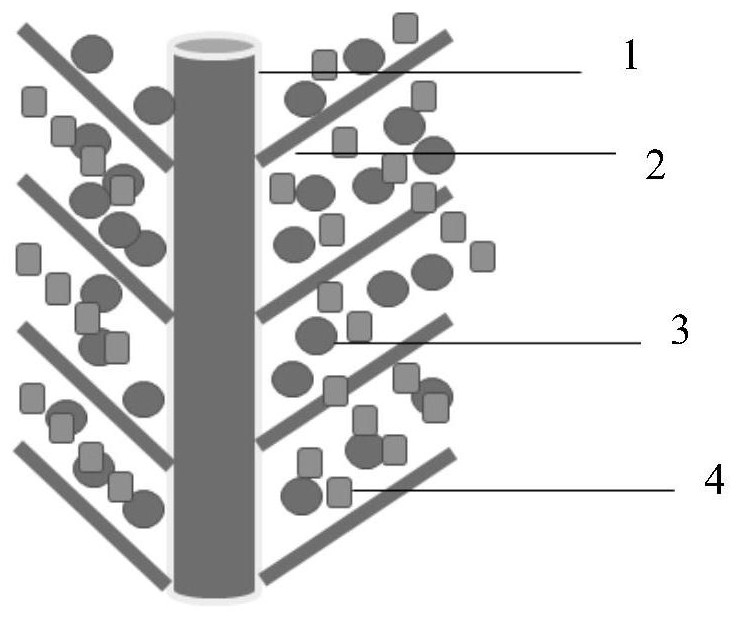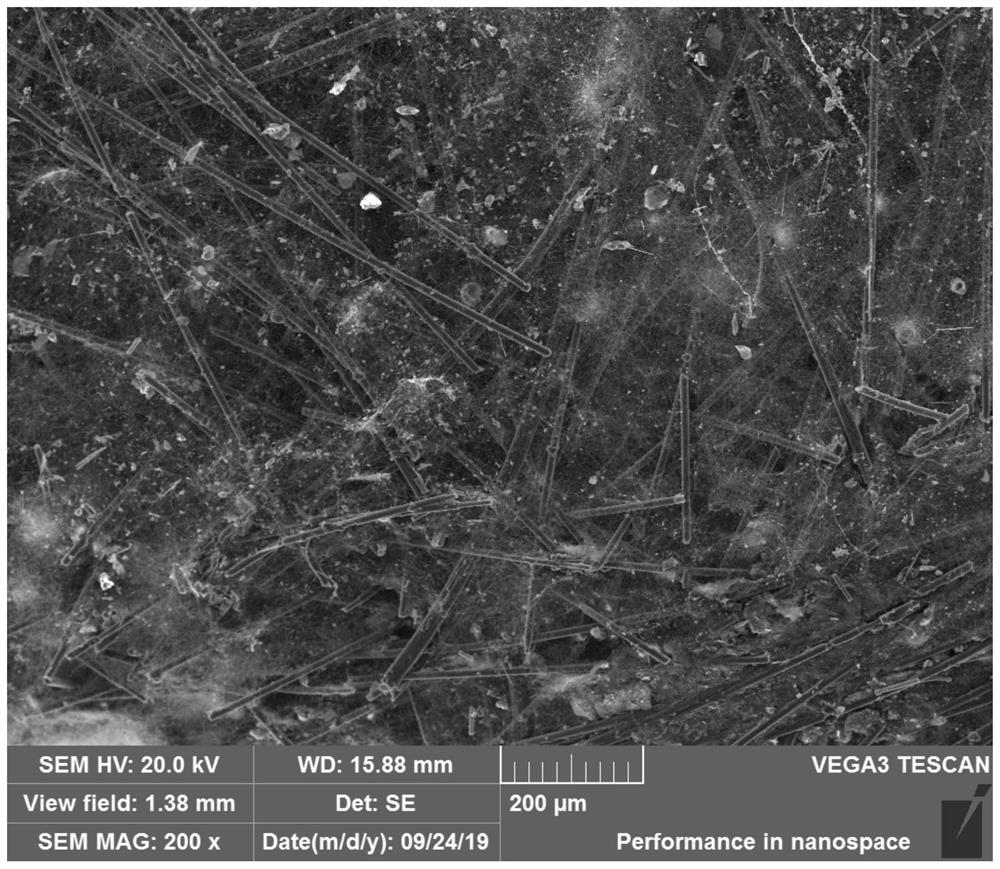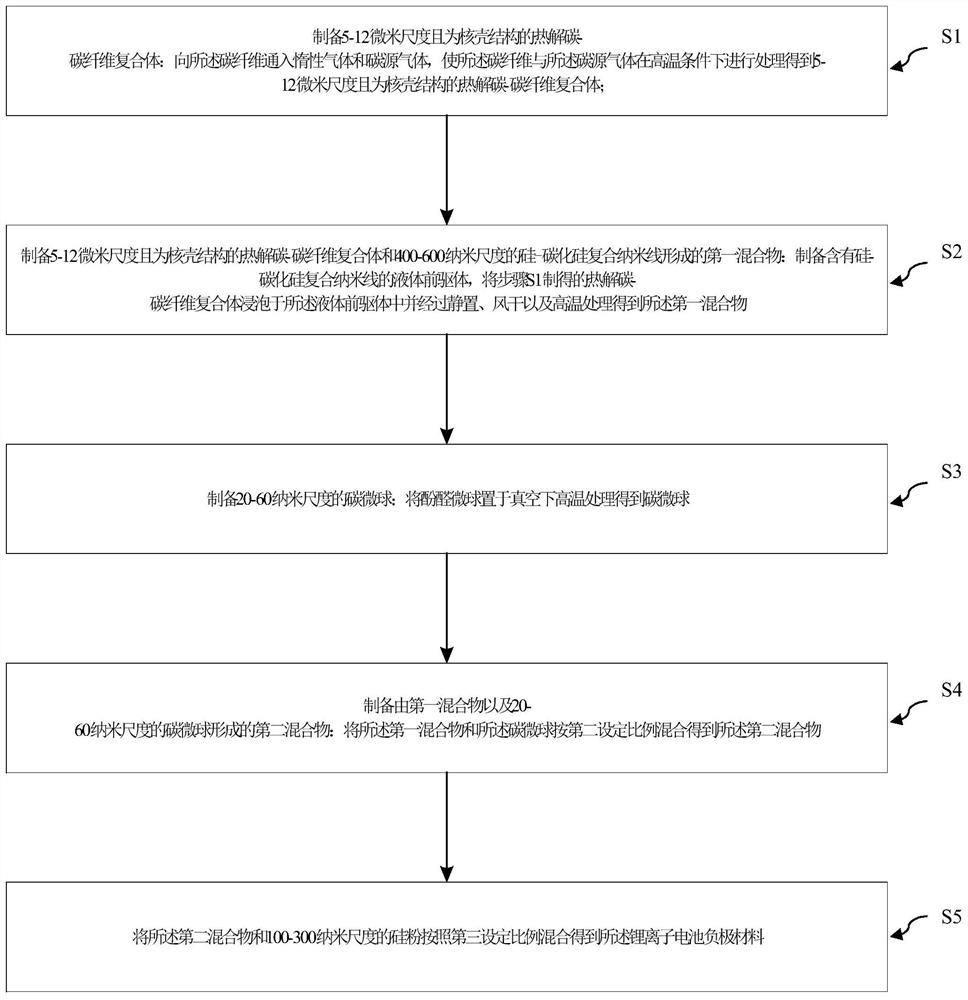Lithium ion battery negative electrode material and preparation method thereof
A technology for lithium ion batteries and negative electrode materials, which is applied in battery electrodes, secondary batteries, carbon preparation/purification, etc., can solve the problems of low specific capacity and stability, improve specific capacity and stability, and improve bonding degree. Effect
- Summary
- Abstract
- Description
- Claims
- Application Information
AI Technical Summary
Problems solved by technology
Method used
Image
Examples
preparation example Construction
[0045] Such as image 3 Shown, the preparation method of this lithium-ion battery negative electrode material comprises the following steps:
[0046] S1. Preparation of pyrolytic carbon-carbon fiber composites with a scale of 5-12 microns and a core-shell structure: pass inert gas and carbon source gas into the carbon fibers, and process the carbon fibers and carbon source gas at high temperature to obtain 5-12 microns Pyrolytic carbon-carbon fiber composites with a core-shell structure.
[0047] Wherein, the inert gas may be argon, and the carbon source gas may be methane; the flow rate of the carbon source gas may be 0.2-0.5 L / min; the flow rate of the inert gas may be 0.5-1.0 L / min.
[0048] Specifically, in some embodiments, the carbon fiber can be placed in a high-temperature furnace at a temperature of 800-1000 degrees, and methane and argon can be passed through for 1-3 hours to obtain a 5-12 micron scale and a core-shell structure. pyrolytic carbon-carbon fiber compo...
Embodiment 1
[0058] (1) Put the carbon fiber in a high-temperature furnace, and treat it for 1 hour at a temperature of 800 degrees, a methane flow rate of 0.2L / min, and an argon flow rate of 0.5L / min to obtain sample A; sample A is 5-12 Pyrolytic carbon-carbon fiber composites with micron scale and core-shell structure.
[0059] (2) Mix ethyl orthosilicate and absolute ethanol in a molar ratio of 1:5, stir evenly, then add hydrochloric acid, the ratio of hydrochloric acid to ethyl orthosilicate is 1:10, continue stirring for 1 hour, and the obtained liquid Marked as B; B is the liquid precursor containing silicon-silicon carbide composite nanowires.
[0060] Soak sample A in liquid B, immerse at room temperature for 36 hours, and dry naturally in the air to obtain a sample marked as C; where C is a pyrolytic carbon-carbon fiber composite mixed with a liquid precursor.
[0061] Sample C was placed in an argon atmosphere, under the condition of 1000 degrees, high-temperature heat treatment...
Embodiment 2
[0066] (1) Put the carbon fiber in a high-temperature furnace, and treat it for 3 hours at a temperature of 1000 degrees, a methane flow rate of 0.5L / min, and an argon flow rate of 1.0L / min to obtain sample A; sample A is 5-12 Pyrolytic carbon-carbon fiber composites with micron scale and core-shell structure.
[0067] (2) Mix ethyl orthosilicate and absolute ethanol in a molar ratio of 1:2, stir evenly, then add hydrochloric acid, the ratio of hydrochloric acid to ethyl orthosilicate is 1:15, continue stirring for 2 hours, and the obtained liquid Marked as B; B is the liquid precursor containing silicon-silicon carbide composite nanowires.
[0068] Soak sample A in liquid B, immerse at room temperature for 48 hours, and dry naturally in the air to obtain a sample marked as C; where C is a pyrolytic carbon-carbon fiber composite mixed with a liquid precursor.
[0069] Sample C was placed in an argon atmosphere, subjected to high-temperature heat treatment at 1200 degrees for ...
PUM
| Property | Measurement | Unit |
|---|---|---|
| diameter | aaaaa | aaaaa |
| diameter | aaaaa | aaaaa |
| diameter | aaaaa | aaaaa |
Abstract
Description
Claims
Application Information
 Login to View More
Login to View More - R&D
- Intellectual Property
- Life Sciences
- Materials
- Tech Scout
- Unparalleled Data Quality
- Higher Quality Content
- 60% Fewer Hallucinations
Browse by: Latest US Patents, China's latest patents, Technical Efficacy Thesaurus, Application Domain, Technology Topic, Popular Technical Reports.
© 2025 PatSnap. All rights reserved.Legal|Privacy policy|Modern Slavery Act Transparency Statement|Sitemap|About US| Contact US: help@patsnap.com



